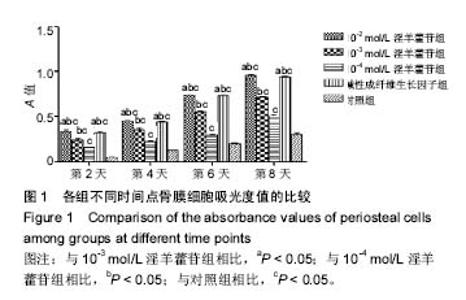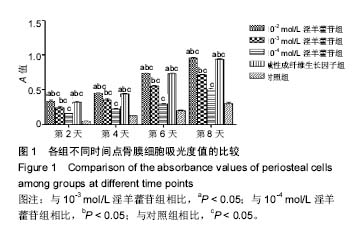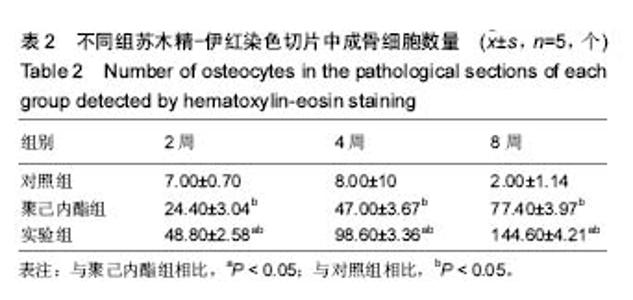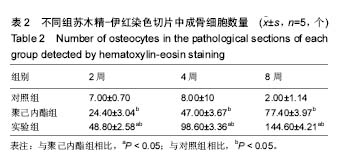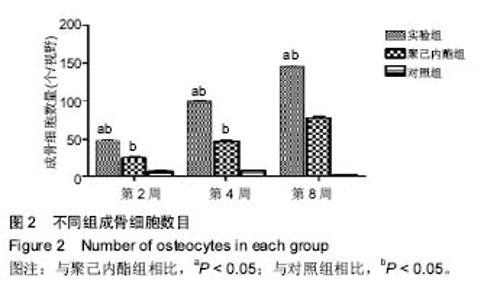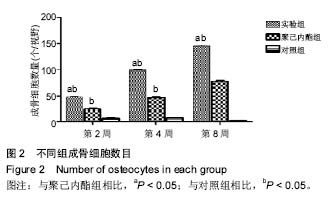Chinese Journal of Tissue Engineering Research ›› 2018, Vol. 22 ›› Issue (10): 1477-1482.doi: 10.3969/j.issn.2095-4344.0704
Tissue-engineered bone constructed by icariin-induced periosteal cells repairs bone defects
- the People’s Hospital of Longhua of Shenzhen, Shenzhen 518109, Guangdong Province, China
-
Received:2017-11-14Online:2018-04-08Published:2018-04-08 -
Contact:Luo Mei-lan, Nurse, the People’s Hospital of Longhua of Shenzhen, Shenzhen 518109, Guangdong Province, China -
About author:Zhong Xiu-xia, Pharmacist, the People’s Hospital of Longhua of Shenzhen, Shenzhen 518109, Guangdong Province, China -
Supported by:the Science and Technology Program of Jiangxi Province, No. 20161BBG02315
CLC Number:
Cite this article
Zhong Xiu-xia, Luo Mei-lan. Tissue-engineered bone constructed by icariin-induced periosteal cells repairs bone defects[J]. Chinese Journal of Tissue Engineering Research, 2018, 22(10): 1477-1482.
share this article

2.1 实验动物数量分析 整个实验中有3只兔死亡,均按照实验步骤予以补充。 2.2 不同组骨膜细胞增殖情况 各组骨膜细胞增殖情况见表1,图1。 各组骨膜细胞吸光度值随时间增加均呈上升趋势,以10-2 mol/L组和碱性成纤维细胞生长因子组最明显,并于第8周分别达最大值(0.95±0.03,0.94±0.03)。析因方差分析结果证实,不同组对骨膜细胞吸光度值有影响(F=400.02,P < 0.001);不同时间对骨膜细胞吸光度值有影响(F=8.46,P < 0.001);不同时间和处理组间有交互作用(F=2 598.76,P < 0.001)。与对照组相比,不同浓度的淫羊藿苷组在不同的时间点均显著促进骨膜细胞增殖(P < 0.05);且 10-2 mol/L淫羊藿苷组与碱性成纤维细胞生长因子组相比,无明显差异(P > 0.05)。"

| [1]Barg A, Bettin CC, Burstein AH, et al. Early Clinical and Radiographic Outcomes of Trabecular Metal Total Ankle Replacement Using a Transfibular Approach.J Bone Joint Surg Am. 2018;100(6):505-515. [2]Jiang H, Cheng P, Li D, et al.Novel standardized massive bone defect model in rats employing an internal eight-hole stainless steel plate for bone tissue engineering.J Tissue Eng Regen Med. 2018. doi: 10.1002/term.[3]Kessler S, He K, Ukia MW. Bone morphogeneric protein2 accelerates osteointegration and remodelling of sovent-dehydrated bone substitutes. Arch Orthop Trauma Surg.2004;2124(2006):2410-2414.[4]uttappan S, Anitha A, Minsha MG, et al. BMP2 expressing genetically engineered mesenchymal stem cells on composite fibrous scaffolds for enhanced bone regeneration in segmental defects.Mater Sci Eng C Mater Biol Appl. 2018; 85:239-248.[5]吴涛,徐俊昌,南开辉,等.淫羊藿苷促进羊骨髓间充质干细胞的增殖和成骨分化[J].中国组织工程研究与临床康复, 2009,13(19): 3725-3729.[6]Zhao J, Ohba S, Shinkai M, et al. Icariin induces osteogenic differentiation in vitro in a BMP- and Runx2-dependent manner. Biochem Biophys Res Commun. 2008;369: 444-448[7]Saghebasl S, Davaran S, Rahbarghazi R, et al.Synthesis and in vitro evaluation of thermosensitive hydrogel scaffolds based on (PNIPAAm-PCL-PEG-PCL-PNIPAAm)/Gelatin and (PCL-PEG-PCL)/Gelatin for use in cartilage tissue engineering. J Biomater Sci Polym Ed. 2018:1-22..[8]Ozkan O, Sasmazel HT. Antibacterial Performance of PCL-Chitosan Core-Shell Scaffolds. J Nanosci Nanotechnol. 2018;18(4):2415-2421.[9]Nuntanaranont T, Promboot T, Sutapreyasri S.Effect of expanded bone marrow-derived osteoprogenitor cells seeded into polycaprolactone/tricalcium phosphate scaffolds in new bone regeneration of rabbit mandibular defects.J Mater Sci Mater Med. 2018;29(3):24. [10]Saveleva MS, Ivanov AN, Kurtukova MO, et al.Hybrid PCL/CaCO<sub>3</sub> scaffolds with capabilities of carrying biologically active molecules: Synthesis, loading and in vivo applications.Mater Sci Eng C Mater Biol Appl. 2018; 85:57-67.[11]李婧.骨膜来源细胞在骨组织工程应用中的研究进展[J].中国美容整形外科杂志,2015,8:496-499.[12]邢飞,彭静,陈龙.等.组织工程骨膜包被双相陶瓷磷酸钙修复兔尺骨缺损[J].中国组织工程研究, 2016, 20(47):7006-7013.[13]Park HC, Son YB, Lee SL, et al. Effects of Osteogenic-Conditioned Medium from Human Periosteum-Derived Cells on Osteoclast Differentiation.Int J Med Sci. 2017;14(13):1389-1401.[14]Yoon DK, Park JS, Rho GJ, et al. The involvement of histone methylation in osteoblastic differentiation of human periosteum-derived cells cultured in vitro under hypoxic conditions. Cell Biochem Funct. 2017;35(7):441-452.[15]陈苏平,李平. ESW对兔成骨细胞增殖影响的实验研究[J].当代医学,2012,18(4):150-152.[16]张黎声,韩小晶,罗志荣,等.淫羊藿苷对大鼠骨髓间充质干细胞迁移作用的影响[J].中国中医药信息杂志,2017, 24(2):44-48.[17]李军,宋光明,孙明林,等.淫羊藿苷对高重力下成骨细胞MC3T3-E1增殖与凋亡的影响[J].中国医药导报,2017, 14(6): 19-23.[18]张温花,张文超,于远东.淫羊藿苷对前列腺癌细胞株活力、迁移与侵袭的作用[J].中国病理生理杂志,2017, 33(6):1017-1020.[19]马婷,王丽娜,李子坚,等.淫羊藿苷抗肿瘤作用的研究进展[J].现代肿瘤医学,2017,25(9):1505-1508.[20]戴娜桑.中药提取物淫羊藿苷作为骨质疏松症抑制剂的试验研究[J].玉林师范学院学报,2016,37(1):120-123.[21]张钰,陈鹏,张登军,等.淫羊藿苷对大鼠坐骨神经离断后修复与再生的影响[J].中华手外科杂志,2016, 32(1):59-61.[22]陈澜.淫羊藿苷对大鼠创伤性脑损伤后白细胞介素1β和肿瘤坏死因子α的作用[J].中国新药与临床杂志,2017, 36:65-68.[23]贺宪,孔畅,曾巧,等.淫羊藿苷对骨性关节炎家兔BMSCs增殖及软骨定向分化影响的实验研究[J].湖南中医杂志, 2017,33(3): 140-143.[24]李利生,史源泉,龚其海.淫羊藿苷抗尿酸钠诱导的大鼠急性痛风性关节炎作用[J].中国实验方剂学杂志,2017,23:15-18.[25]Marta C, Rodolfo M, Laura T, et al.Dental pulp stem cells for bone tissue engineering: a review of the current literature and a look to the future.Regen Med. 2018. doi: 10.2217/rme-2017-0112.[26]Tellado SF, Chiera S, Bonani W, et al.Heparin functionalization increases retention of TGF-β2 and GDF5 on biphasic silk fibroin scaffolds for tendon/ligament-to-bone tissue engineering.Acta Biomater. 2018. pii: S1742-7061(18)30137-5.[27]Fiume E, Barberi J, Verné E, et al. Bioactive Glasses: From Parent 45S5 Composition to Scaffold-Assisted Tissue-Healing Therapies.J Funct Biomater. 2018;9(1). pii: E24.[28]Dalgic AD, Alshemary AZ, Tezcaner A, et al.Silicate-doped nano-hydroxyapatite/graphene oxide composite reinforced fibrous scaffolds for bone tissue engineering.J Biomater Appl. 2018:885328218763665.[29]Hoffmann A, Leonards H, Tobies N, et al.New stereolithographic resin providing functional surfaces for biocompatible three-dimensional printing.J Tissue Eng. 2017; 8:2041731417744485.[30]Shpichka A, Koroleva A, Kuznetsova D, et al.Fabrication and Handling of 3D Scaffolds Based on Polymers and Decellularized Tissues.Adv Exp Med Biol. 2017;1035:71-81. [31]张峻玮,陆海涛,杨宇明,等.低氧培养对骨膜细胞成软骨分化的影响[J],中华实验外科杂志.2016,33(5):1281-1283.[32]姜文涛,梅伟,王庆德,等.淫羊藿苷对成骨细胞增殖、分化及矿化的影响[J].中华实验外科杂志,2017, 34(03):446-448.Lee CJ, Moon SJ, Jeong JH, et al.Kaempferol targeting on the fibroblast growth factor receptor 3-ribosomal S6 kinase 2 signaling axis prevents the development of rheumatoid arthritis. Cell Death Dis. 2018;9(3):401.[1]Barg A, Bettin CC, Burstein AH, et al. Early Clinical and Radiographic Outcomes of Trabecular Metal Total Ankle Replacement Using a Transfibular Approach.J Bone Joint Surg Am. 2018;100(6):505-515. [2]Jiang H, Cheng P, Li D, et al.Novel standardized massive bone defect model in rats employing an internal eight-hole stainless steel plate for bone tissue engineering.J Tissue Eng Regen Med. 2018. doi: 10.1002/term.[3]Kessler S, He K, Ukia MW. Bone morphogeneric protein2 accelerates osteointegration and remodelling of sovent-dehydrated bone substitutes. Arch Orthop Trauma Surg.2004;2124(2006):2410-2414.[4]uttappan S, Anitha A, Minsha MG, et al. BMP2 expressing genetically engineered mesenchymal stem cells on composite fibrous scaffolds for enhanced bone regeneration in segmental defects.Mater Sci Eng C Mater Biol Appl. 2018; 85:239-248.[5]吴涛,徐俊昌,南开辉,等.淫羊藿苷促进羊骨髓间充质干细胞的增殖和成骨分化[J].中国组织工程研究与临床康复, 2009,13(19): 3725-3729.[6]Zhao J, Ohba S, Shinkai M, et al. Icariin induces osteogenic differentiation in vitro in a BMP- and Runx2-dependent manner. Biochem Biophys Res Commun. 2008;369: 444-448[7]Saghebasl S, Davaran S, Rahbarghazi R, et al.Synthesis and in vitro evaluation of thermosensitive hydrogel scaffolds based on (PNIPAAm-PCL-PEG-PCL-PNIPAAm)/Gelatin and (PCL-PEG-PCL)/Gelatin for use in cartilage tissue engineering. J Biomater Sci Polym Ed. 2018:1-22..[8]Ozkan O, Sasmazel HT. Antibacterial Performance of PCL-Chitosan Core-Shell Scaffolds. J Nanosci Nanotechnol. 2018;18(4):2415-2421.[9]Nuntanaranont T, Promboot T, Sutapreyasri S.Effect of expanded bone marrow-derived osteoprogenitor cells seeded into polycaprolactone/tricalcium phosphate scaffolds in new bone regeneration of rabbit mandibular defects.J Mater Sci Mater Med. 2018;29(3):24. [10]Saveleva MS, Ivanov AN, Kurtukova MO, et al.Hybrid PCL/CaCO<sub>3</sub> scaffolds with capabilities of carrying biologically active molecules: Synthesis, loading and in vivo applications.Mater Sci Eng C Mater Biol Appl. 2018; 85:57-67.[11]李婧.骨膜来源细胞在骨组织工程应用中的研究进展[J].中国美容整形外科杂志,2015,8:496-499.[12]邢飞,彭静,陈龙.等.组织工程骨膜包被双相陶瓷磷酸钙修复兔尺骨缺损[J].中国组织工程研究, 2016, 20(47):7006-7013.[13]Park HC, Son YB, Lee SL, et al. Effects of Osteogenic-Conditioned Medium from Human Periosteum-Derived Cells on Osteoclast Differentiation.Int J Med Sci. 2017;14(13):1389-1401.[14]Yoon DK, Park JS, Rho GJ, et al. The involvement of histone methylation in osteoblastic differentiation of human periosteum-derived cells cultured in vitro under hypoxic conditions. Cell Biochem Funct. 2017;35(7):441-452.[15]陈苏平,李平. ESW对兔成骨细胞增殖影响的实验研究[J].当代医学,2012,18(4):150-152.[16]张黎声,韩小晶,罗志荣,等.淫羊藿苷对大鼠骨髓间充质干细胞迁移作用的影响[J].中国中医药信息杂志,2017, 24(2):44-48.[17]李军,宋光明,孙明林,等.淫羊藿苷对高重力下成骨细胞MC3T3-E1增殖与凋亡的影响[J].中国医药导报,2017, 14(6): 19-23.[18]张温花,张文超,于远东.淫羊藿苷对前列腺癌细胞株活力、迁移与侵袭的作用[J].中国病理生理杂志,2017, 33(6):1017-1020.[19]马婷,王丽娜,李子坚,等.淫羊藿苷抗肿瘤作用的研究进展[J].现代肿瘤医学,2017,25(9):1505-1508.[20]戴娜桑.中药提取物淫羊藿苷作为骨质疏松症抑制剂的试验研究[J].玉林师范学院学报,2016,37(1):120-123.[21]张钰,陈鹏,张登军,等.淫羊藿苷对大鼠坐骨神经离断后修复与再生的影响[J].中华手外科杂志,2016, 32(1):59-61.[22]陈澜.淫羊藿苷对大鼠创伤性脑损伤后白细胞介素1β和肿瘤坏死因子α的作用[J].中国新药与临床杂志,2017, 36:65-68.[23]贺宪,孔畅,曾巧,等.淫羊藿苷对骨性关节炎家兔BMSCs增殖及软骨定向分化影响的实验研究[J].湖南中医杂志, 2017,33(3): 140-143.[24]李利生,史源泉,龚其海.淫羊藿苷抗尿酸钠诱导的大鼠急性痛风性关节炎作用[J].中国实验方剂学杂志,2017,23:15-18.[25]Marta C, Rodolfo M, Laura T, et al.Dental pulp stem cells for bone tissue engineering: a review of the current literature and a look to the future.Regen Med. 2018. doi: 10.2217/rme-2017-0112.[26]Tellado SF, Chiera S, Bonani W, et al.Heparin functionalization increases retention of TGF-β2 and GDF5 on biphasic silk fibroin scaffolds for tendon/ligament-to-bone tissue engineering.Acta Biomater. 2018. pii: S1742-7061(18)30137-5.[27]Fiume E, Barberi J, Verné E, et al. Bioactive Glasses: From Parent 45S5 Composition to Scaffold-Assisted Tissue-Healing Therapies.J Funct Biomater. 2018;9(1). pii: E24.[28]Dalgic AD, Alshemary AZ, Tezcaner A, et al.Silicate-doped nano-hydroxyapatite/graphene oxide composite reinforced fibrous scaffolds for bone tissue engineering.J Biomater Appl. 2018:885328218763665.[29]Hoffmann A, Leonards H, Tobies N, et al.New stereolithographic resin providing functional surfaces for biocompatible three-dimensional printing.J Tissue Eng. 2017; 8:2041731417744485.[30]Shpichka A, Koroleva A, Kuznetsova D, et al.Fabrication and Handling of 3D Scaffolds Based on Polymers and Decellularized Tissues.Adv Exp Med Biol. 2017;1035:71-81. [31]张峻玮,陆海涛,杨宇明,等.低氧培养对骨膜细胞成软骨分化的影响[J],中华实验外科杂志.2016,33(5):1281-1283.[32]姜文涛,梅伟,王庆德,等.淫羊藿苷对成骨细胞增殖、分化及矿化的影响[J].中华实验外科杂志,2017, 34(03):446-448.Lee CJ, Moon SJ, Jeong JH, et al.Kaempferol targeting on the fibroblast growth factor receptor 3-ribosomal S6 kinase 2 signaling axis prevents the development of rheumatoid arthritis. Cell Death Dis. 2018;9(3):401. |
| [1] | Zhang Tongtong, Wang Zhonghua, Wen Jie, Song Yuxin, Liu Lin. Application of three-dimensional printing model in surgical resection and reconstruction of cervical tumor [J]. Chinese Journal of Tissue Engineering Research, 2021, 25(9): 1335-1339. |
| [2] | Li Cai, Zhao Ting, Tan Ge, Zheng Yulin, Zhang Ruonan, Wu Yan, Tang Junming. Platelet-derived growth factor-BB promotes proliferation, differentiation and migration of skeletal muscle myoblast [J]. Chinese Journal of Tissue Engineering Research, 2021, 25(7): 1050-1055. |
| [3] | Liu Cong, Liu Su. Molecular mechanism of miR-17-5p regulation of hypoxia inducible factor-1α mediated adipocyte differentiation and angiogenesis [J]. Chinese Journal of Tissue Engineering Research, 2021, 25(7): 1069-1074. |
| [4] | Zeng Yanhua, Hao Yanlei. In vitro culture and purification of Schwann cells: a systematic review [J]. Chinese Journal of Tissue Engineering Research, 2021, 25(7): 1135-1141. |
| [5] | Ma Zetao, Zeng Hui, Wang Deli, Weng Jian, Feng Song. MicroRNA-138-5p regulates chondrocyte proliferation and autophagy [J]. Chinese Journal of Tissue Engineering Research, 2021, 25(5): 674-678. |
| [6] | Xu Dongzi, Zhang Ting, Ouyang Zhaolian. The global competitive situation of cardiac tissue engineering based on patent analysis [J]. Chinese Journal of Tissue Engineering Research, 2021, 25(5): 807-812. |
| [7] | Wang Yujiao, Liu Dan, Sun Song, Sun Yong. Biphasic calcium phosphate loaded with advanced platelet rich fibrin can promote the activity of rabbit bone marrow mesenchymal stem cells [J]. Chinese Journal of Tissue Engineering Research, 2021, 25(4): 504-509. |
| [8] | Zhou Jihui, Yao Meng, Wang Yansong, Li Xinzhi, Zhou You, Huang Wei, Chen Wenyao. Influence of novel nanoscaffolds on biological behaviors of neural stem cells and the related gene expression [J]. Chinese Journal of Tissue Engineering Research, 2021, 25(4): 532-536. |
| [9] | Wu Zijian, Hu Zhaoduan, Xie Youqiong, Wang Feng, Li Jia, Li Bocun, Cai Guowei, Peng Rui. Three-dimensional printing technology and bone tissue engineering research: literature metrology and visual analysis of research hotspots [J]. Chinese Journal of Tissue Engineering Research, 2021, 25(4): 564-569. |
| [10] | Chang Wenliao, Zhao Jie, Sun Xiaoliang, Wang Kun, Wu Guofeng, Zhou Jian, Li Shuxiang, Sun Han. Material selection, theoretical design and biomimetic function of artificial periosteum [J]. Chinese Journal of Tissue Engineering Research, 2021, 25(4): 600-606. |
| [11] | Liu Fei, Cui Yutao, Liu He. Advantages and problems of local antibiotic delivery system in the treatment of osteomyelitis [J]. Chinese Journal of Tissue Engineering Research, 2021, 25(4): 614-620. |
| [12] | Li Xiaozhuang, Duan Hao, Wang Weizhou, Tang Zhihong, Wang Yanghao, He Fei. Application of bone tissue engineering materials in the treatment of bone defect diseases in vivo [J]. Chinese Journal of Tissue Engineering Research, 2021, 25(4): 626-631. |
| [13] | Zhang Zhenkun, Li Zhe, Li Ya, Wang Yingying, Wang Yaping, Zhou Xinkui, Ma Shanshan, Guan Fangxia. Application of alginate based hydrogels/dressings in wound healing: sustained, dynamic and sequential release [J]. Chinese Journal of Tissue Engineering Research, 2021, 25(4): 638-643. |
| [14] | Chen Jiana, Qiu Yanling, Nie Minhai, Liu Xuqian. Tissue engineering scaffolds in repairing oral and maxillofacial soft tissue defects [J]. Chinese Journal of Tissue Engineering Research, 2021, 25(4): 644-650. |
| [15] | Xing Hao, Zhang Yonghong, Wang Dong. Advantages and disadvantages of repairing large-segment bone defect [J]. Chinese Journal of Tissue Engineering Research, 2021, 25(3): 426-430. |
| Viewed | ||||||
|
Full text |
|
|||||
|
Abstract |
|
|||||
